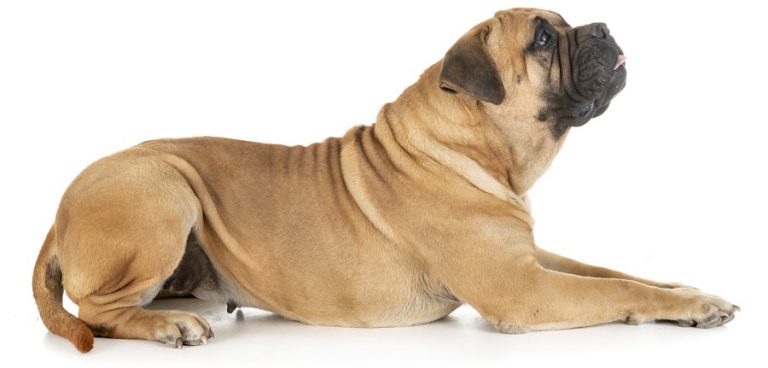Tibetan Mastiff Growth Chart – Size & Weight Chart
Tibetan Mastiffs are known to be great guard dogs because of their protective intuition, big build, and agility, hence making them the perfect guardian.
Keeping a Tibetan Mastiff growth chart with you will help in monitoring the changes in your puppy as they grow and prepares you for what to expect.
Are you wondering how big a Tibetan Mastiff gets when they are fully grown? Typically, a female Tibetan Mastiff weighs between 70 and 120 pounds with a height of around 24 to 27 inches.
On the other hand, a male Tibetan Mastiff weighs between 90 and 150 pounds with a height of around 26 to 29 inches.
They reach their adult size at around the age of 18 months, but some continue to grow.
Read on to learn more about Tibetan Mastiff weight chart, the factors that can affect their growth, and the health conditions affecting them as a breed.
When Is A Tibetan Mastiff Fully Grown?
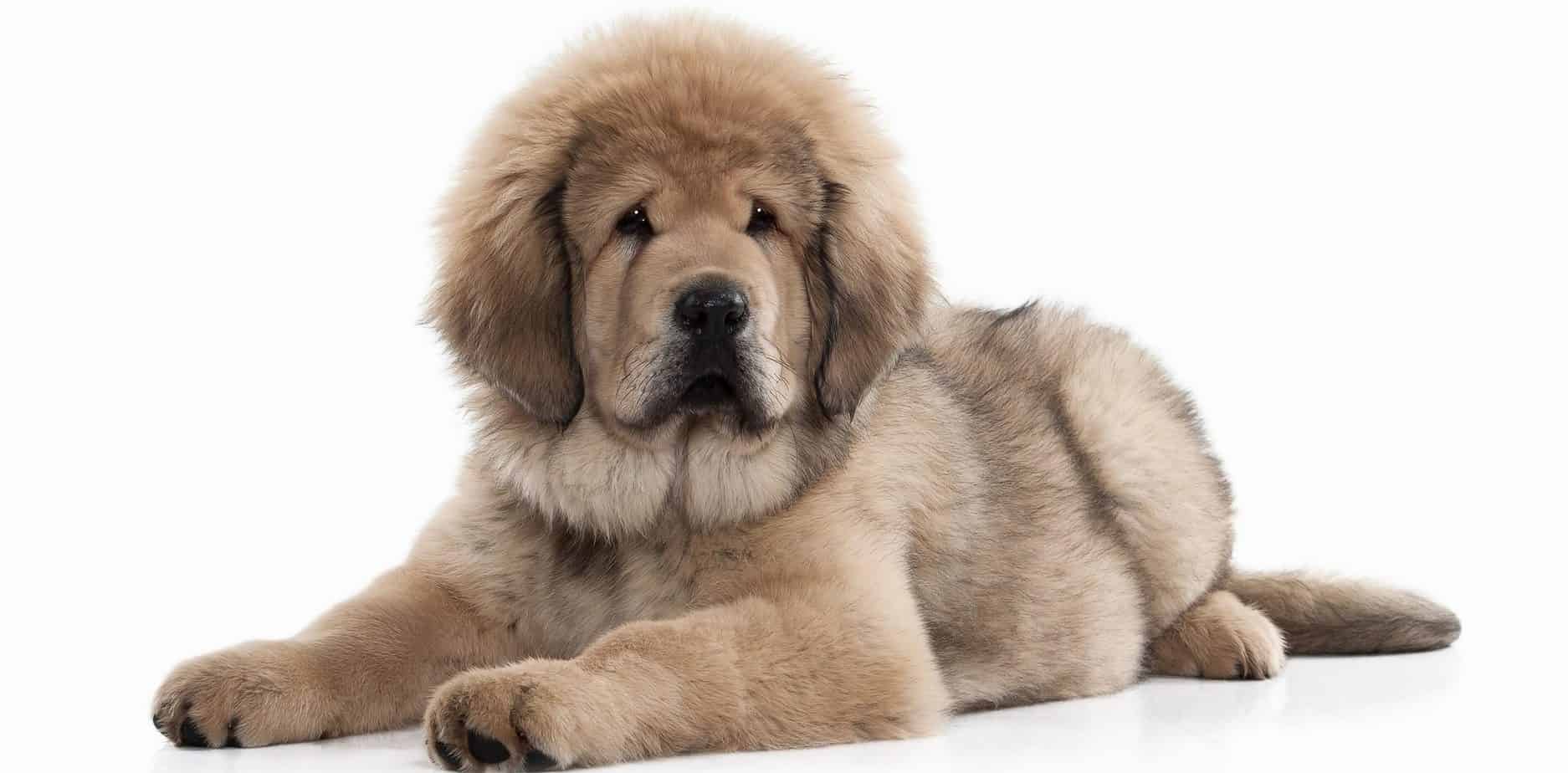
Tibetan Mastiff is a large breed dog like the Mastiffs and Great Danes, hence taking longer to be fully grown. Female Tibetan Mastiffs reach their adult size earlier than their male counterparts.
Typically, Tibetan Mastiffs reach their adult size at around the age of 18 months. However, some Tibetan Mastiffs may continue to grow slowly even up to the age of 5 years.
Some females may take 3 to 4 years to be fully grown while some males take 4 to 6 years. Certain factors that can affect the growth of a Tibetan Mastiff include genetics, nutrition, physical activity, and health.
Therefore, regular visits to the vet will ensure that the growth of your dog is not affected by anything that can be stopped with the help of a vet.
Tibetan Mastiff Weight Chart
A Tibetan Mastiff puppy will grow two to eight ounces per day during the first weeks and the growth will turn into 1 to 3 pounds per week eventually.
This growth may not be similar for all puppies because of certain factors such as the milk intake from their mother and the size of the litter.
Typically, Tibetan Mastiffs have faster growth in their early months in terms of length and height.
If you look at the Tibetan Mastiff growth chart, you can see that their weight starts to slow down when they reach the adolescent age of one year.
You will start seeing their lean parts and muscle mass being filled. Do not be surprised if your Tibetan Mastiff looks unproportionate because some parts of their body grow before others.
Generally, the weight of a male Tibetan Mastiff is between 33 and 48 pounds at the age of 3 months.
At 6 months, they weigh between 63 and 91 pounds, and at 1 year, they weigh between 92 and 140 pounds.
On the other hand, a female Tibetan Mastiff weighs between 27 and 40 pounds at 3 months old. They weigh between 72 and 73 pounds at 6 months old and weigh between 75 and 78 pounds at 1 year old.
Tibetan Mastiff Puppy Weight Chart
| Age | Female Weight lbs | Male Weight lbs |
|---|---|---|
| 3 Months | 25 - 40 lbs | 30 - 45 lbs |
| 4 Months | 30 - 45 lbs | 45 - 65 lbs |
| 5 Months | 35 - 60 lbs | 50 - 75 lbs |
| 6 Months | 40 - 60 lbs | 55 - 85 lbs |
| 7 Months | 45 - 65 lbs | 60 - 90 lbs |
| 8 Months | 50 - 70 lbs | 65 - 95 lbs |
| 9 Months | 55 - 80 lbs | 70 - 105 lbs |
| 10 Months | 55 - 90 lbs | 70 - 115 lbs |
| 11 Months | 60 - 100 lbs | 75 - 125 lbs |
| 12 Months | 60 - 110 lbs | 80 - 135 lbs |
| 24 Months | 70 - 120 lbs | 90 - 150 lbs |
Tibetan Mastiff Growth Chart – What to Expect
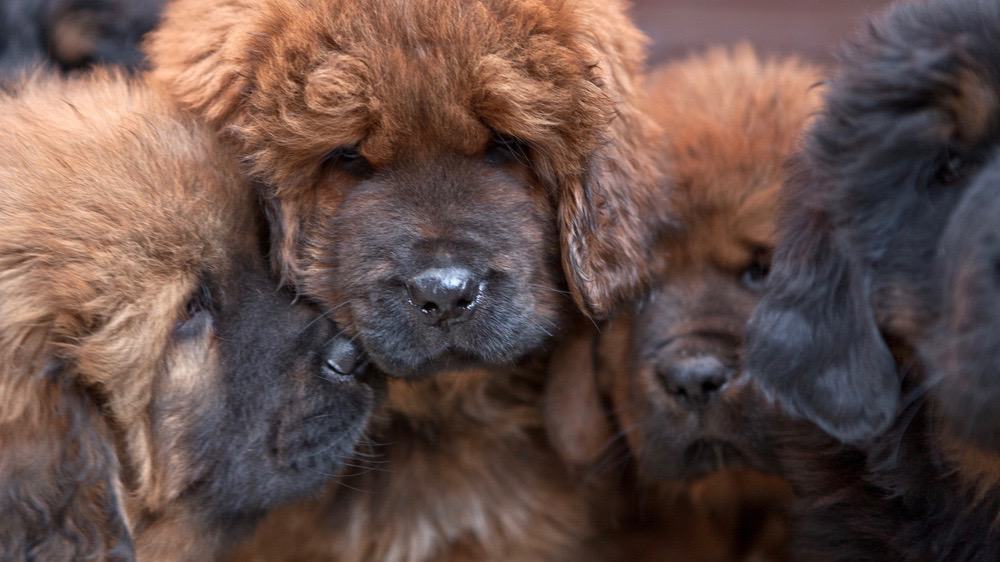
The following are the stages of growth that you can expect from your Tibetan Mastiff puppy:
Birth – 2 Weeks
This phase is known as the neonatal or newborn stage. At this stage, the puppy is completely blind and deaf because the eyes and the ears are closed and yet developed. That is why they spend most of their time sleeping.
During this phase, the puppy gets their nutrition from the mother’s milk and the mother does most of the job including cleaning the puppy and keeping them warm as they are not able to regulate their body temperature.
3 Weeks – 12 Weeks
At three weeks, the puppy’s ears, and eyes open and they start being curious and aware of their littermates and environment. At four weeks, the puppy’s first teeth come out and the breeder can introduce food to them.
At 8 weeks, the puppy can be separated from the mother as they should be fully weaned and depend on puppy food for their nutrition. Housetraining should be done at this stage as well as socialization and training.
When the puppy is three months old, you can start exercising slowly so that they maintain a healthy weight. You should also speak to your vet about vaccinating and de-worming your puppy.
4 Months – 9 Months
This is the adolescent stage where the puppy shows increased stubbornness, territoriality, and disobedience.
Therefore, more socialization and training are crucial at this stage to ensure that the puppy knows their position in the family as they show their dominance at this stage as well.
This is also the period where the permanent teeth erupt, and your puppy begins chewing and will try to nibble anything that comes across their eyes.
The puppy will also show signs of fear and you should show your support and reliability in this phase so that you can develop trust between you and your puppy.
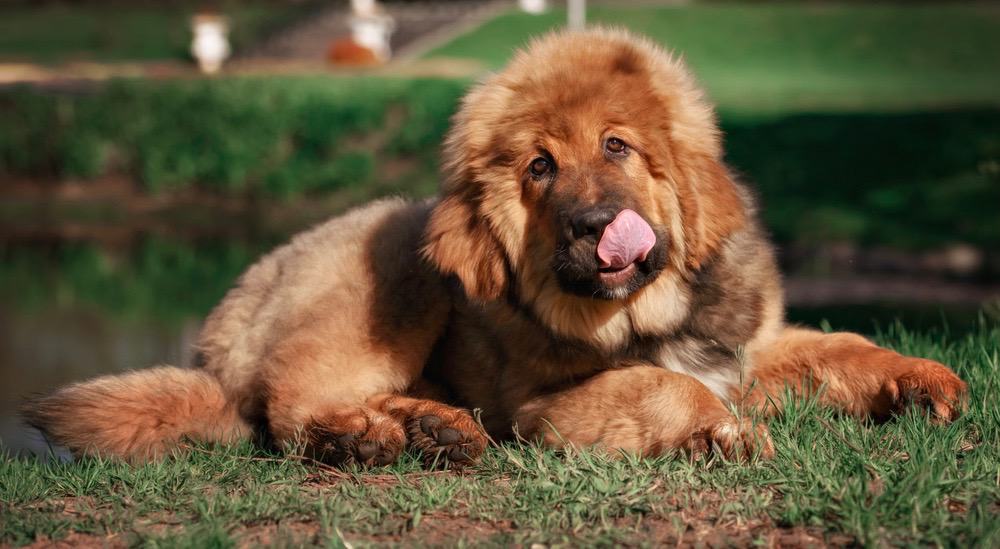
10 Months – 18 Months
This is the phase where your Tibetan Mastiff begins showing the behavioral characteristics of this breed by becoming balanced, good-natured, and obedient.
However, they need more training and education to ensure that the traits are fully portrayed as adults.
This is the stage to switch your dog from puppy food to adult food as they are transitioning into adulthood.
The process should be done slowly to avoid upsetting your puppy’s stomach and causing diarrhea or vomiting.
Your Tibetan Mastiff reaches sexual maturity at this stage. Therefore, you should speak to your vet about spaying or neutering if you are not planning on breeding them.
Adult
As adults, Tibetan Mastiffs are considered mentally, physically, and sexually mature. Tibetan Mastiffs reach their adult weight and height at the age of 18 months to two years, and some take up to 5 years to be fully grown.
This is the stage where you provide healthy and balanced meals to your puppy as well as exercise them to ensure that they achieve optimal growth, and they live long and happy.
How Big Do Tibetan Mastiffs Get?
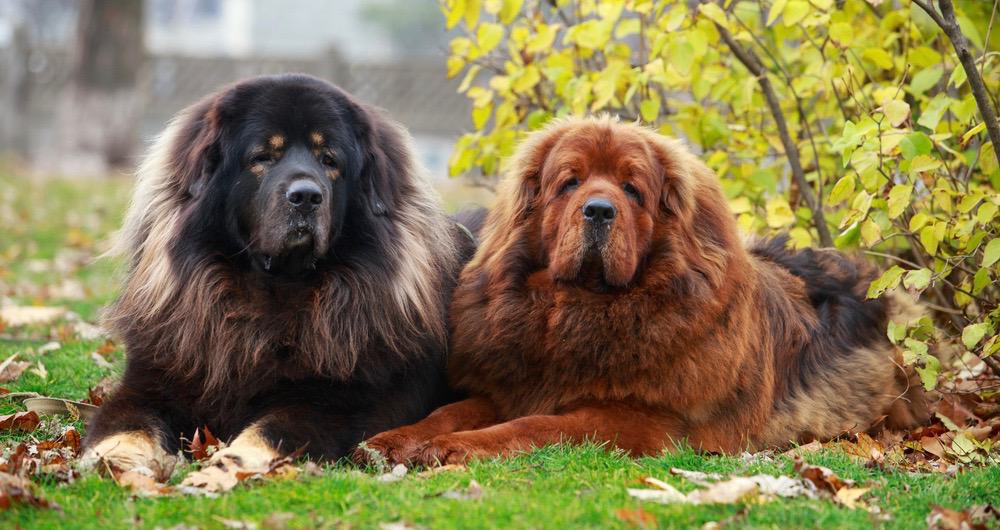
There are three ways that you can predict how big your Tibetan Mastiff will get as an adult. This includes the parents, paw size, and DNA test.
Looking at the size of the parents can tell you how big your puppy will get.
If you got your Tibetan Mastiff from the breeder, ask them to give you information about the size of your puppy’s parents and the size of the previous litters so that you can predict your puppy’s size as an adult.
Another way to predict your puppy’s size is to look at their paw size. If they look oversized next to their legs and body, then they are still growing but if they look proportional to the body, then your puppy has reached their adult size.
Finally, you can do a DNA test if you do not have access to the parents’ information and you can predict the adult size of your Tibetan Mastiff with the results.
On average, a male Tibetan Mastiff weighs between 90 and 150 pounds with a height of around 26 to 29 inches.
On the other hand, a female Tibetan Mastiff weighs between 70 and 120 pounds with a height of around 24 to 27 inches.
Will Neutering/Spaying My Tibetan Mastiff Affect His Growth?
Spaying and neutering involve the surgical removal of ovaries and fallopian tubes in females and testicles in males respectively. You must keep your Tibetan Mastiff intact up to the age of 18 months or even two years.
This is because the growth plates are regulated by hormones, and if they are removed before your Tibetan Mastiff completes their growth, they will experience various bone, joint, and growth issues as well as weight issues.
There are benefits to spaying or neutering your Tibetan Mastiff. Spaying reduces the risk of pyometra, mammary tumors, uterine tumors, and perianal fistulas.
On the other hand, neutering reduces the risk of testicular cancer, prostate disorders, and possibly diabetes.
Tibetan Mastiff Size Chart
Knowing how to measure the height of your Tibetan Mastiff is necessary for various reasons. One, you will be able to buy clothing and harness that fit them properly.
Two, you will get them the right kennel and kennel door, and finally, you will be required to give the measurements if your dog participates in shows and competitions.
To measure your dogs’ height, let them stand on flat ground and ensure that they are straight to get accurate measurements. Take a measuring tape and measure from the ground to the withers, and this is your dog’s height.
Generally, the height of a female Tibetan Mastiff is between 24 to 27 inches while a male Tibetan Mastiff has a height of between 26 to 29 inches.
Kangal vs Tibetan Mastiff Size
Both the Kangal and Tibetan Mastiff are large breeds of dogs that were used for guarding. However, the Kangal is larger than the Tibetan Mastiff.
The weight of a male Kangal is between 106 and 132 pounds with a height of 28 and 31 inches. The female Kangal weighs between 88 and 110 pounds with a height of 25 to 30 inches.
On the other hand, a male Tibetan Mastiff weighs between 90 and 105 pounds with a height of between 26 and 29 inches while a female weighs between 70 and 120 pounds with a height of 24 and 27 inches.
Factors That Affect Tibetan Mastiff Growth
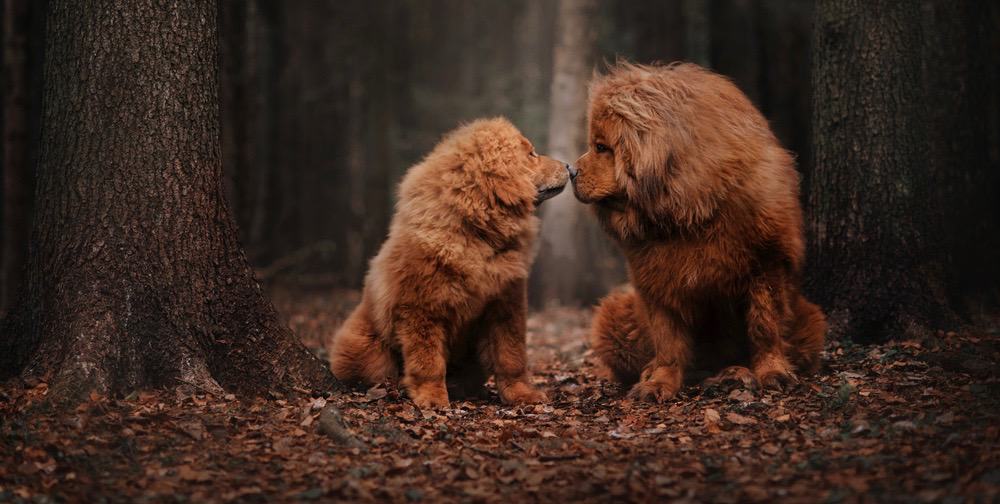
Genetics and Gender
The main predictor of your Tibetan Mastiff size is the size of their parent breeds. The size will turn out almost like that of the parents.
The male Tibetan Mastiffs grow faster and bigger than the male ones. Reach out to the breeder to get to learn about the parents of your puppy. It will also help you to learn about the genetic health conditions to expect.
Nutrition
Tibetan Mastiff needs proper nutrition to live longer and remain healthy. A healthy breed of Tibetan Mastiff has a 10 to 12 years lifespan.
An unhealthy diet and table food may lead to obesity or overweight. A proper nutritious meal will help your puppy develop and grow healthy. Always consult with your vet to ensure you are in check with your dog’s diet.
Physical Activity and Health
Physical activities and moderate exercise are good for your Tibetan Mastiff to keep them in shape. Tibetan mastiffs are not a fan of games, but they love going on walks.
Change the route often to avoid them being too territorial. They require one hour of daily exercise. Exercise keeps your puppy’s health in check. It also helps in maintaining their weight. However, ensure you do not overwork your puppy.
What if my Tibetan Mastiff is not the right weight?
Tibetan Mastiffs require proper nutrition to stay healthy. Underweight or overweight pups are prone to several health problems that can end their lives.
Your puppy’s healthy weight is the weight that matches the average range for their age. The following are indicators of ideal weight:
Enough waist indentation – The dog with an unexaggerated hourglass figure is okay. You should be able to see your puppy waist.
Fat between the ribs and fur – When you feel your dog’s ribs, you will know they are healthy when there is enough fat between the ribs and the fur.
Good energy – This breed loves staying put because they are not playful. However, Tibetan Mastiffs enjoy work-related exercises and have a short burst of energy.
If you find your Tibetan Mastiff is always up for a stroll or goes on defense mode, then they are in good shape.
When you find your dog does not have a healthy weight. It is important to do the following:
Provide a healthy diet – A healthy diet will help your dog stay within the right weight. Provide a high-quality meal to your Tibetan Mastiff as approved by your veterinarian.
Control food intake – Manage the quantity of your dog’s meal. Tibetan Mastiffs need only two cups of quality dog food daily. Split the meals into small portions rather than giving them the day’s meal all at once.
Prepare home-cooked meals – Home-cooked food is better than commercially prepared food. Prepare your Tibetan Mastiff with quality ingredients that are good for their health.
If you have tried the above-suggested recommendation and your puppy is still not responding. Consult your vet to get more consultation on how to help your puppy to have a healthy weight.
Tibetan Mastiff Genetics and Common Health Problems
The following are common health problems that affect Tibetan Mastiff:
Dental disease is a common problem that affects 80% of dogs by two years. This condition starts with the build-up of tartar causing an infection of the teeth gums and roots. Dental disease can be prevented or treated to avoid loss of teeth or kidneys, joints, heart, or liver damage.
Infections – Tibetan Mastiffs are prone to viral or bacterial infections such as rabies, parvo, and distemper. Most of these infections are prevented through vaccinations.
Obesity is a disease that can cause metabolic and digestive disorders, heart disease, back pain, or worsen joint problems.
The following are genetic predispositions that affect Tibetan Mastiff:
Bone and Joint problems – Tibetan Mastiffs can suffer from different musculoskeletal problems. However, they can be treated after diagnosis to prevent undue pain.
Cataracts – This is a common cause of blindness during the Tibetan Mastiff golden age. Removal of cataracts through surgery can help restore the dog’s sight.
Blindness is also known as PRA (Progressive Retinal Atrophy), is a disease that affects the eyes that are genetically programmed to go blind. Tibetan Mastiffs are more likely to get this disease. It is not curable but can be genetically tested.
Other genetic health problems include bleeding disorders, epilepsy, allergies, mange, thyroid problems, and nerve disorders.
Final Words
Since Tibetan Mastiffs are large dogs, you need to be aware that they will grow to take much of the space in your home. Therefore, ensure that you have enough space for them both outside and inside your home.
Once you take your puppy home, ensure that they are adequately trained and exercised as they can remain stubborn, and this will ensure that they have great temperaments where they are aware of their boundaries set both mentally and physically

